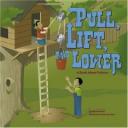If you are beginning to teach simple machines to your students, Michael Dahl’s book Pull, Lift, and Lower: A Book About Pulleys, is an easy to understand introduction to the way pulleys work. The illustrations by Denise Shea are simple, yet show enough detail for children to comprehend the mechanics of pulleys.
The author begins the book by using the crane to introduce the concept of lifting heavy objects. He then gives children easy to comprehend definitions of the simple machine and pulley. “A simple machine is anything that helps people do work.” “A pulley uses a wheel and a rope, or cable. The rope wraps over the wheel. When the rope is pulled at one end, the wheel helps lift the rope on the other end.” Children are then shown examples of pulleys that they are probably familiar with, such as window blind cords and flag poles. The author continues to introduce and explain to the reader different types of pulleys in easy to understand text. For example, “Some pulleys use more than one wheel. More wheels make a load easier to lift. A block and tackle is a combination of several wheels and ropes that work together.” The author closes with another image of the crane and the idea that “Pulleys help keep the world moving.”
Curriculum Connections
This book would be a great way to introduce the study of simple machines in your classroom. It seems best suited to 2nd and 3rd graders. The concepts presented would integrate well with science lessons where the students investigate and understand types of simple machines (lever, screw, pulley, wheel and axle, inclined plane, and wedge) and their uses, (SOL 3.2 a, b) and become familiar with examples found in the school, home, and work environment. (SOL 3.2d)
Additional Resources
- The back pages in the book provide a simple experiment, some fun facts on pulleys, and a glossary. Also included is list of additional books on simple machines.
- Other books in this series, such as Scoop, Seesaw, and Raise: A Book About Levers, and Roll, Slope, and Slide: A Book About Ramps would be useful in continuing lessons about simple machines.
- Daily Doings With Simple Machines is a nice homework scavenger hunt to incorporate with the lesson. If Simple Machines Weren’t Around… is another printable to get kids thinking about the benefits of simple machines.
- Marvelous Machine Experiments provides some good ideas for classroom experiments.
Book: Pull, Lift, and Lower: A Book About Pulleys
Author: Michael Dahl
Illustrator: Denise Shea
Publisher: Picture Window Books
Publication Date: July 2002
Pages: 24 pages
Grade Range: 1-3
ISBN: 978-1404819085

